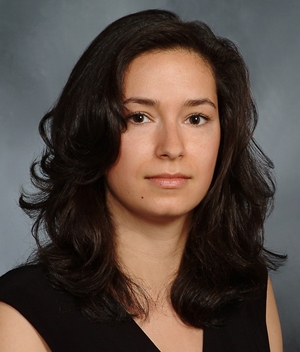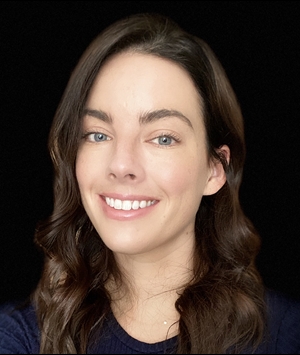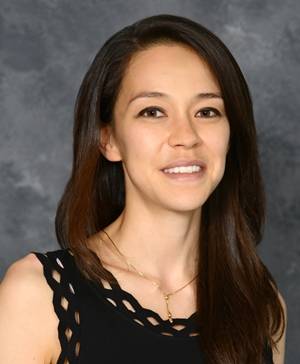When the Workforce Health and Safety (WHS) team at New York Presbyterian Hospital issued a call for volunteers to help triage the increasing number of hospital employees with COVID-19 symptoms, Katerina Dodelzon, MD, assistant professor of clinical radiology and associate director of the breast imaging fellowship at Weill Cornell Medicine, didn’t think twice. She immediately signed up. “I saw there was a need, and as a physician I am compelled to help in any way that I can, particularly in this uncertain time,” says Dodelzon, who is also associate program director for diagnostic radiology for Weill Cornell Imaging at New York Presbyterian.
Dodelzon is among a handful of radiologists who are stepping out of their traditional imaging roles to volunteer with the WHS as part of New York Presbyterian Hospital’s response to the COVID-19 pandemic. New York Presbyterian has campuses throughout New York City, which has reported tens of thousands of COVID-19 cases. With the surge in cases and reported shortages of personal protective equipment, New York Presbyterian, like health systems nationwide, has seen scores of its physicians, nurses, and other staff present with COVID-19 symptoms after caring for patients with the disease. “Our healthcare personnel who have symptoms are at a loss,” Dodelzon says. “Many feel compelled to continue working alongside their colleagues because every pair of hands is desperately needed right now. But they’re developing symptoms and don’t know what to do.”

Katerina Dodelzon, MD, assistant professor of clinical radiology and associate director of the breast imaging fellowship at Weill Cornell Medicine who is also associate program director for diagnostic radiology at Weill Cornell Imaging at New York Presbyterian, says that as a physician, she is compelled to help however she can with the COVID-19 response.
|
New York Presbyterian’s WHS normally assesses providers who’ve had inadvertent needle sticks or other exposures while caring for patients. But with so many personnel falling ill and needing guidance about the best course of action based on their conditions, the WHS needed to expand its team to focus on triaging employees with COVID-19 symptoms. It issued a call for volunteers from radiology and other departments across the hospital to join its ranks.
Kathryn E. Dean, MD, assistant professor of radiology and assistant attending at Weill Cornell Imaging, was among the hundreds of clinicians and non-clinicians to volunteer. “The WHS needed to roll out a system quickly to help with the escalating health issues within our own staff,” Dean says. “I saw this as a way that I could contribute. I’m happy to help.”
Ready to Help
When Dodelzon initially volunteered, she wasn’t entirely sure what serving with the WHS would entail, and she admits that she was concerned about bringing the virus back to her family. She was relieved when the WHS established a virtual system, allowing team members to stay home and triage hospital personnel with symptoms through a phone-based hotline. “Originally, it was intended to be in person, in clinic,” says Dodelzon, who has also volunteered to help in the intensive care unit should the need arise. “But with so many people contracting the disease, we realized that we could achieve the same goals while maintaining that all-important social distancing if we did this virtually.”
WHS leaders developed training videos and other regularly updated materials to help volunteers prepare to triage hospital personnel through the virtual system. Recognizing that many of the volunteers would encounter clinical symptoms and questions outside of their traditional areas of expertise, the WHS provided scenario-based materials to assist the volunteers. “It’s all very algorithmic: If a patient says they have this, then do this,” Dean explains. “It’s easy to learn, and you can always refer back to the training materials or ask another team member for help if something comes up that you’re not sure about.”

Kathryn E. Dean, MD, assistant professor of radiology and assistant attending at Weill Cornell Imaging, says that a big part of what the workforce health and safety team does is provide a sympathetic ear to colleagues who are concerned about COVID-19. |
Volunteers like Aya Y. Michaels, MD, assistant professor of clinical radiology who recently joined the WHS, are also leveraging their existing clinical skills to help their colleagues. “As a breast imager, I spend a lot of time each day speaking to patients, many of whom feel anxious about getting imaged, having a biopsy, or undergoing some other aspect of care,” Michaels says. “As my colleagues call the WHS hotline, I am applying what I’ve learned in patient communication to help them during this very uncertain time. In this case, the caregivers have become the patients, and they are feeling similar anxieties and stress.”
Supportive Care
When New York Presbyterian employees call the WHS hotline, they are connected with a triage team member who asks details about their symptoms, such as their temperature and whether they’re having trouble breathing, to assess the severity of their condition and determine if they need further intervention. Although not every employee is being tested for COVID-19, the WHS team assumes that anyone who calls with symptoms has the disease.
“The symptoms of fatigue and myalgias can feel devastating, but most of the cases are relatively mild,” Dodelzon says. “I advise them on supportive care instructions to follow at home: isolating from family members, taking Tylenol for their fever, and drinking plenty of fluids. I also talk to them about the natural course of the disease in its milder form, provide a lot of reassurance, and tell them when to call their primary care physician if their symptoms escalate.”
With 3,000-3,500 New York Presbyterian employees out sick with COVID-19 symptoms at any given time, the WHS triage team receives as many as 800 calls on weekends and up to 2,000 calls on weekdays. It logs each call into a secure database and follows up with each self-isolating patient seven days later to help them determine whether they should continue to remain quarantined and when they might expect to return to work.

Aya Y. Michaels, MD, assistant professor of clinical radiology at Weill Cornell, is relying in part on her existing patient communication skills to triage her colleagues with COVID-19 symptoms. |
Many patients also have questions about their salaries and about using sick days or other time off. New York Presbyterian is providing employees with four weeks of support care time, paid time off that isn’t deducted from their sick or vacation leave, to recover from the disease or care for family members, Dodelzon notes. “Still, a lot of the people are calling to see if we can clear them to go back to work. They are eager to return and help,” she says. “We have a clearance protocol that we follow to see if they’re improved enough to return to work. If they don’t meet that protocol, then we advise them about how to continue with their care.”
While the WHS team is focused primarily on the health of hospital personnel, it also fields questions from employees about other pandemic-related issues. “Everyone has a different set of circumstances,” Dean explains. “In some cases, the employee may not be sick themselves, but maybe their spouse or kid is sick. Or perhaps someone in their household is immunocompromised, and they’re worried about going to work and potentially being exposed and bringing the virus home to their family. It’s hard for us to answer some of those questions, so some of what we’re doing is providing a sympathetic ear and offering guidance about additional resources.”
Untraditional Role
Most of the radiologists who are volunteering with the WHS team continue to read exams and perform other duties as part of their traditional imaging roles, even though non-essential radiology exams have been postponed as a result of the pandemic. For instance, Dodelzon helped create a virtual curriculum for her residents and remains committed to ensuring they continue their education, and Dean continues to read emergency department imaging on the days that she’s not taking calls for the WHS.
“I sent the WHS my schedule for the month,” Dean says. “I offered to help on the dates that I can be taken off of clinical service in the radiology department without causing too much burden on my colleagues, who have all been really supportive of my work with the WHS.”
While triaging colleagues on behalf of the WHS is not part of radiologists’ traditional roles, those who are volunteering say that now is a time for everyone to help in whatever capacity they can to get the community and the nation through this crisis. “It can be uncomfortable to step out of our traditional roles, particularly in this scary and unknown time,” Dodelzon says. “But we’re all physicians first and radiologists second. We will get through this by banding together as a healthcare community and working as a team. That’s what we do.”




